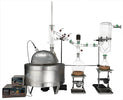
The Differences Between Chinese and USA-Made Glass
, by Adam Ehlers, 5 min reading time

, by Adam Ehlers, 5 min reading time
There are a lot of options for consumers looking to purchase laboratory glassware, and for certain products, you must look more closely than others. One of the most frequently asked questions is about the origin of the glass part in question, is it USA-made or imported?
There are a lot of options for consumers looking to purchase laboratory glassware, and for certain products, you must look more closely than others. One of the most frequently asked questions is about the origin of the glass part in question, is it USA-made or imported? We will take an example part, one that is the hub of the short path distillation process, the distillation head. Below are two images of distillation heads, one made in China (left) and one made in the USA (right). In the end, both of these standard short path heads will accomplish the same goal, right? To a certain extent yes, we as a company have experimented with countless different short path heads over the years, and the basic chemistry of fractional distillation always works out. Your boiling flask will always heat up and your vacuum pump will always achieve a level of vacuum where the botanical compounds boil off and recondense somewhere else within the system. You may be thinking, why would I buy a USA-made glass part if the imported part will do the same job for 1/4 of the price? Let me share some instances that may shed light on that question.


After joining the BVV team years ago, I was tasked with learning more about short path distillation systems. The distillation head is the most crucial piece within the system, so I started by looking into different shapes and sizes. After receiving a few samples from different suppliers, I got to running our short path system in house and recording data on the different parts.
Some common themes that I noticed are the imported glass parts seemed like they were designed by a guy in a dark room with one eye closed. This has nothing to do with the workmanship, but the actual design of lengths and diameters of tubing used. This made the run more time consuming and labor-intensive. It is apparent that the people making these items are looking at a picture and trying to replicate an item rather than designing a part with the process in mind.
Looking at the pictures above, you can clearly see that the extended tube on the right side of each picture is a different diameter. This diameter just so happens to affect the run time based on the vacuum pulling through the tube. Other design flaws in this specific instance included length of condenser and glass thickness. The extended condenser required higher temperatures from the circulator so the oil would not clog, but the temperatures got so high that the standard GL14 barbs would start to melt. The thickness of glass in certain points was unable to hold strong under vacuum pressure and high temperatures, specifically in the Vigreux where my part broke. This leads to another point, craftsmanship.
The other major downside to imported glassware is cheaper materials used. Being overseas, suppliers have less direct communication with the customer and do not feel the same responsibility to help as much as they can. As I mentioned, my Vigreux on one head cracked during the run, causing the vacuum jacket to lose its insulating capacity.
Other things that can be traced to cheaper materials are the greased ground joints not holding as high of vacuum, and the glass tubing having blemishes such as bubbles in the glass. When ground joints are welded to a tube of glass, there is high heat involved to make the two sides melt together. If this is done too close to a ground joint or the ground joint itself is very thin it can become deformed and not create a perfect seal after adding grease. I did not have any bubbles in this round of testing, but I have encountered them many times over the years. They usually occur in a weld where two pieces of glass are joined, and they can structurally compromise the part especially at high temperatures and pressures.
Imported glass is not always useless, as there are plenty of things that are made properly and function just as well as USA-made parts. Thousands of rotary evaporators come out of China every year, and as far as the glass goes it does the same job as USA-made or German-made rotovaps. For general purposes, beakers and flasks that come out of China are just as useful as “higher quality” glass products (keep in mind many parts show up crushed during international shipping). Be sure not to discount a product solely on the fact that it is imported, but dig a little deeper including contacting the manufacturer or looking at reviews.
It may seem like I gave some mixed opinions on if imported glass will ultimately work or not, and a lot of it is up to personal opinions. Buying imported glass through an American company seems to be the best way to handle imported glass if you choose to go that way. It is inspected for damage before shipping to you, and you don’t need to wait 3-4 weeks in transit. If the part arrives broken, it is much easier to file a claim with a domestic company rather than some random manufacturer that can be found on Alibaba.
USA-made glass can have blemishes and deformations as well, and it is the same process to file a claim as long as you are buying from a domestic company. We have seen over the years that USA-made glass is manufactured to a higher quality standard in general, and there are fewer bad apples to weed out.